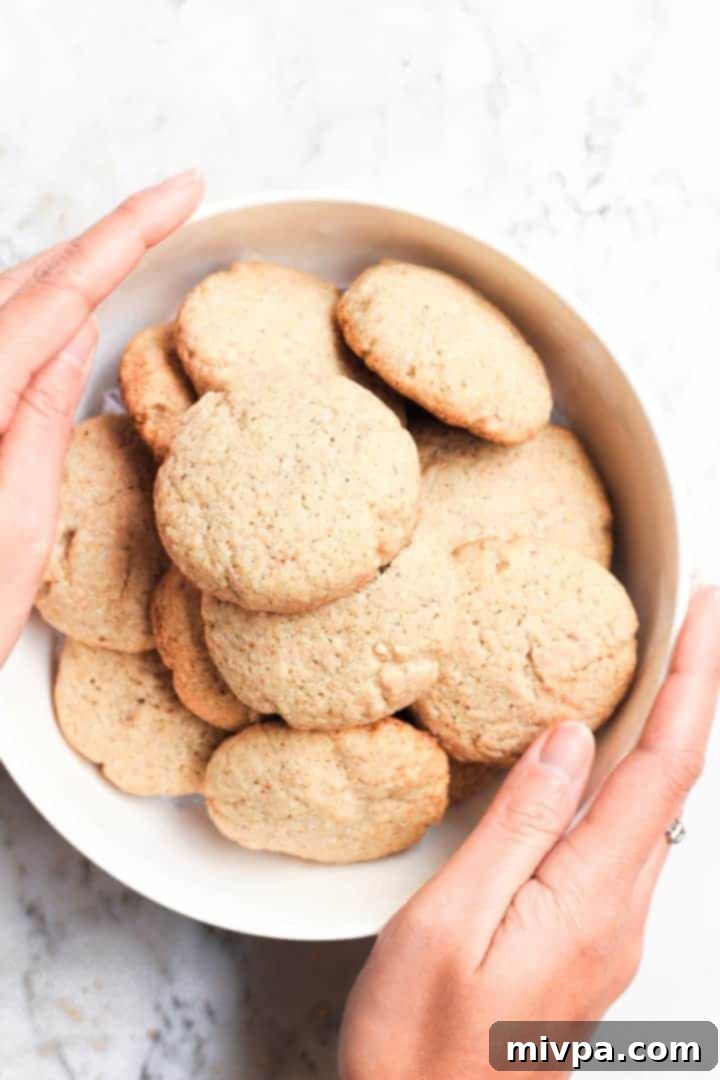Irresistibly Crispy Gluten-Free Buckwheat Cookies: An Easy Homemade & Dairy-Free Recipe
Imagine a batch of warm, perfectly crispy cookies that come together in less than 30 minutes, offering a delightful texture and unique flavor. These exceptional buckwheat cookies are not just a treat for your taste buds; they’re also an incredibly versatile addition to your culinary repertoire. Ideal for a quick breakfast, a satisfying snack anytime, or even charming holiday treats, these cookies cater to various occasions. Best of all, they are entirely gluten-free and dairy-free, making them a fantastic option for those with dietary restrictions or anyone looking for a healthier alternative. As an added bonus, I’ll guide you through the surprisingly simple process of making your own buckwheat flour at home using just a blender – it’s much easier than you think!
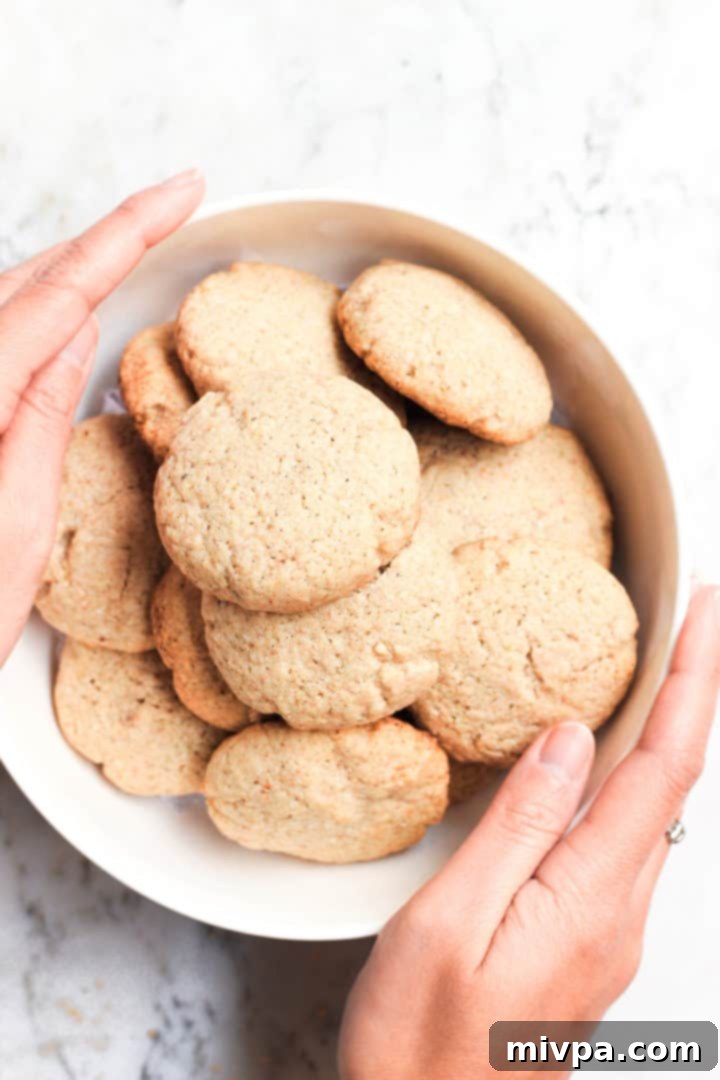
Unveiling Buckwheat: A Gluten-Free Superfood
If you’re new to the world of buckwheat, don’t let its name mislead you. Despite “wheat” being in its title, buckwheat is entirely unrelated to wheat grains. In fact, it’s not a grain at all but rather a unique and powerful seed, often hailed as a superfood. The most exciting revelation for many is that buckwheat is naturally gluten-free. This is fantastic news for individuals like my husband, Juan, who has Celiac disease and experiences severe reactions to gluten. It means he can enjoy a wide array of delicious foods prepared with buckwheat without any concerns.
The common confusion between buckwheat and traditional grains stems from the appearance of buckwheat groats. These distinctively triangular seeds bear a striking resemblance to grains, which has led to buckwheat being classified as a “pseudocereal.” This classification is further reinforced by its culinary versatility; buckwheat seeds can be cooked and utilized in many ways similar to cereals, such as crafting a hearty buckwheat porridge, much like you would prepare oatmeal.
Buckwheat boasts a distinctive nutty and earthy flavor profile, which can be an acquired taste for some. However, once you become accustomed to its unique character, you’ll likely find yourself thoroughly enjoying it. Beyond its delightful taste, buckwheat is also an excellent source of dietary fiber, a crucial component for digestive health and overall well-being. This significant nutritional benefit alone provides ample reason to incorporate buckwheat into your daily diet.
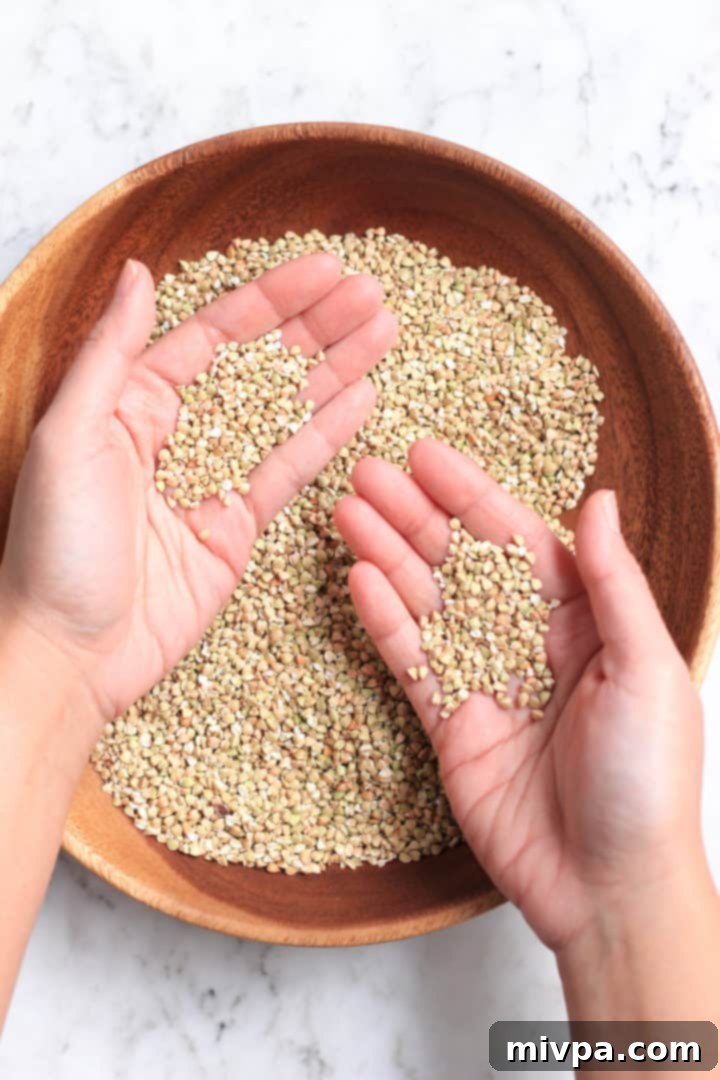
Exploring the Culinary Potential of Buckwheat
A while ago, I purchased a bag of buckwheat groats with the intention of experimenting in the kitchen. While I had successfully used them to make comforting buckwheat porridge, I found myself pondering other creative ways to utilize the remaining groats. It’s always exciting to discover new applications for staple ingredients, especially those with such fantastic health benefits.
During my research, I stumbled upon a simple technique circulating online: grinding buckwheat groats into flour. Given that pre-packaged buckwheat flour often costs significantly more than the groats themselves, I realized this was an ingenious way to save money and ensure freshness. With my reliable blender at hand, I was eager to create my very own homemade buckwheat flour. This not only proved to be incredibly cost-effective but also opened up a whole new world of gluten-free baking possibilities.
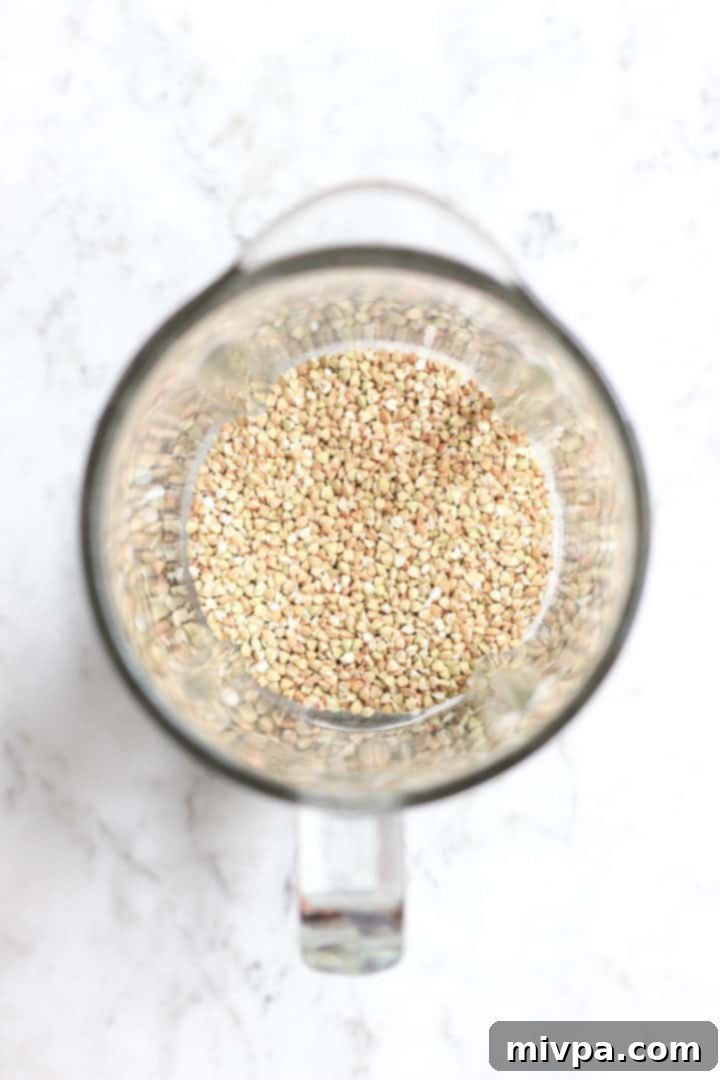
Effortless Homemade Buckwheat Flour
Creating your own buckwheat flour is surprisingly straightforward, and it’s a game-changer for home bakers. Here’s the simple method:
Start by placing about half a cup of buckwheat groats into your blender. It’s best to work in smaller batches to ensure an even grind. Blend the groats until they transform into a super fine, powdery flour. This typically takes around 45 seconds, depending on the power of your blender. You’ll notice the resulting flour has a distinct grayish-white hue. Repeat this process until you have the desired quantity of flour for your recipe.
Using a high-speed or heavy-duty blender will make this task even easier and more efficient, yielding a wonderfully fine flour texture. The simplicity of this process is truly remarkable; knowing how effortless it is, I now rarely purchase pre-ground buckwheat flour if I have whole groats available. It’s a satisfying and economical way to ensure you always have fresh, high-quality buckwheat flour on hand for all your gluten-free baking adventures.
Delightful Buckwheat Flour Creations:
- Soft, Fluffy Buckwheat Bread (Gluten-Free, Dairy-Free)
- Buckwheat Banana Bread (Gluten-Free, Dairy-Free)
- Easy Buckwheat Crepes (Gluten-Free, Dairy-Free)
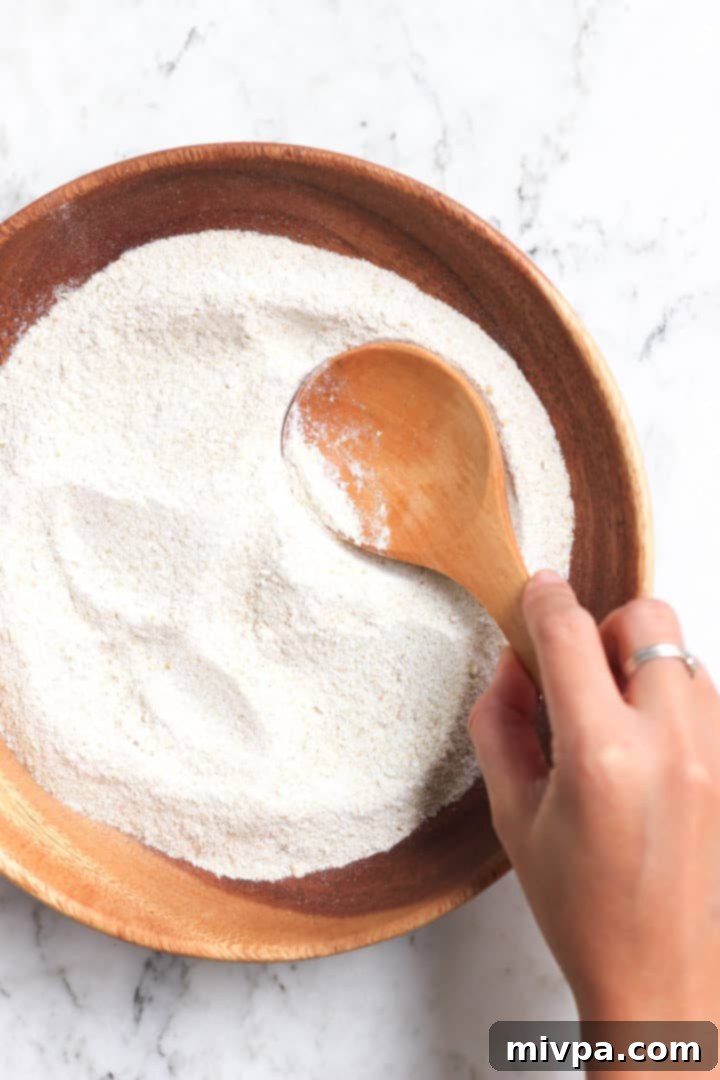
Crafting Perfect Buckwheat Flour Cookies
With a fresh batch of my homemade buckwheat flour ready, I was eager to create some delicious cookies. To my absolute delight, the process of making these buckwheat cookies was remarkably simple, defying any preconceptions about baking with alternative flours. These cookies truly impressed me with their fantastic texture and distinctive flavor.
Each bite of these delightful buckwheat cookies offers an incredible experience: a wonderfully crispy exterior gives way to a beautifully soft and tender interior. They are truly addictively good, and the best part is how quickly they come together – even factoring in the time it takes to grind your own groats! What I particularly adore about these gluten-free buckwheat cookies is their unique and memorable flavor. They possess an earthy, slightly nutty taste that beautifully sets them apart from conventional cookies, offering a sophisticated and wholesome alternative.
If you’ve been hesitant to bake with buckwheat flour, now is the perfect opportunity to dive in, and this recipe is an ideal starting point. Buckwheat flour is an extraordinary gluten-free substitute for traditional wheat flour, imparting a delicious earthy depth to your baked goods. Furthermore, its user-friendly nature makes it a joy to work with, even for novice bakers. Embrace the goodness of buckwheat and elevate your cookie game!
Why You’ll Love This Buckwheat Cookie Recipe:
- Simple, Accessible Ingredients: You won’t need to hunt for obscure items! All the ingredients required for these gluten-free buckwheat cookies are readily available at your local grocery store, ensuring a hassle-free shopping experience.
- Effortless Preparation: This recipe is designed for simplicity. Preparing the cookie dough is as easy as combining the wet ingredients with the dry, then forming small, easily flattened balls before they head to the oven. Minimal fuss, maximum enjoyment!
- Unforgettable Texture: The textural contrast in these cookies is simply divine. I particularly love their crisp outer layer that gives way to a wonderfully soft and tender inside. They are perfectly balanced and make an excellent choice for breakfast, a relaxing teatime treat, or a satisfying snack any time of day.
- Completely Gluten-Free and Dairy-Free: This is arguably the best feature of this fantastic recipe. It is 100% gluten-free and dairy-free. This means that individuals with Celiac disease, gluten allergies, or lactose intolerances can indulge in these delicious buckwheat cookies without a single worry, offering a truly inclusive treat.
Essential Ingredients & Smart Substitutions:
- Sugar: For this delightful buckwheat cookie recipe, I opted for classic white sugar. However, feel free to get creative with your sweeteners! You can successfully substitute with light brown sugar, dark brown sugar, or even coconut sugar. Just remember that the darker the sugar, the richer and deeper the color of your cookie dough and final baked cookies will be. For those managing blood sugar levels, such as individuals with diabetes or insulin resistance, I highly recommend Lakanto monk fruit sweetener, a fantastic 1:1 sugar substitute with a zero glycemic index that won’t impact your blood sugar.
- Coconut Oil: I personally prefer using refined coconut oil in my baking because of its neutral taste, which allows the other flavors to shine through. Extra virgin coconut oil has a more pronounced coconut aroma and flavor, which you might enjoy if you like that hint of coconut. For a dairy-free alternative, vegan butter is an excellent choice. If dairy isn’t an issue for you, unsalted butter or ghee can be used in equal quantities.
- Egg: If you have an egg allergy or simply wish to keep this recipe entirely egg-free and vegan, there are great substitutes available. Consider using an egg-replacer powder, aquafaba (the liquid from a can of chickpeas), or easily make a flax egg at home.
- Homemade Buckwheat Flour: As discussed, making your own buckwheat flour is simple and ensures maximum freshness. To do so, grind buckwheat groats in your high-speed blender. It’s best to process them 1/2 cup at a time to achieve a fine consistency. Typically, 1 1/4 cups of whole buckwheat groats will yield approximately 1 1/2 cups of fine buckwheat flour.
- Buckwheat Flour Color: The final color of your buckwheat flour, and consequently your cookies, can vary. This depends on whether the flour was milled from hulled buckwheat groats (which produce a lighter-colored flour) or from groats with the hulls still on (resulting in a darker, more rustic flour). Both work wonderfully, it’s primarily an aesthetic difference.
- Baking Powder: Baking powder is the sole leavening agent in this recipe, so it’s essential for achieving that perfect rise and texture. Ensure you add the specified amount. If you are Celiac or have a gluten intolerance, it’s crucial to use a certified gluten-free baking powder to avoid cross-contamination.
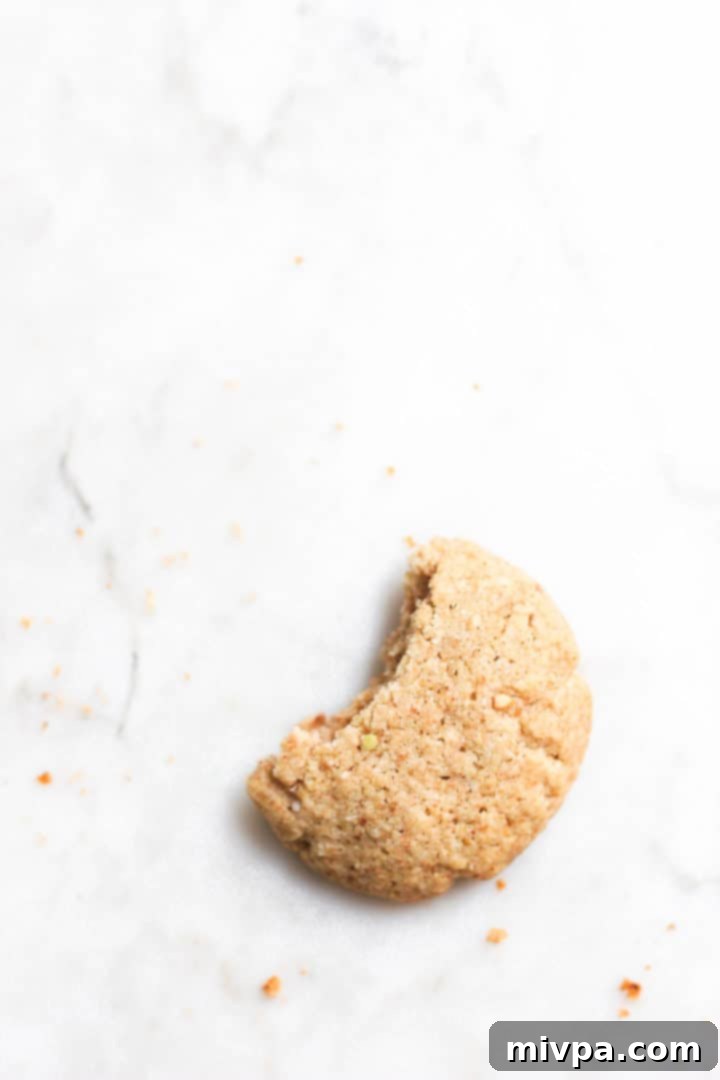
Your Step-by-Step Guide to Baking Buckwheat Cookies:
1. Preheat Oven & Prepare Baking Sheet
Begin by preheating your oven to 350°F (180°C). While the oven heats up, prepare a large cookie sheet by lining it with either parchment paper or a silpat baking mat. This ensures your delicious cookies won’t stick and makes for easy cleanup.
2. Mix Wet Ingredients
In a spacious mixing bowl, combine the sugar and softened coconut oil. Beat them together until they are well integrated and creamy. Next, crack in the egg (or your chosen egg substitute) and mix thoroughly until all ingredients are perfectly combined, creating a smooth wet base for your dough.
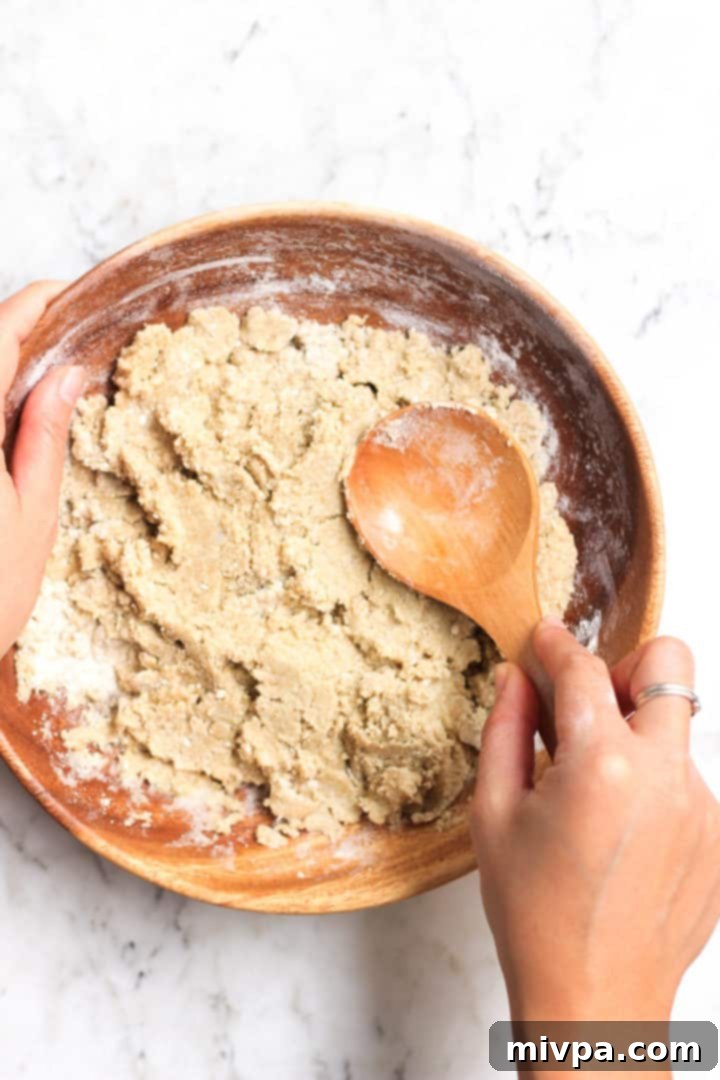
3. Incorporate Dry Ingredients & Form Dough
Now, add the buckwheat flour, baking powder, and a pinch of salt to the wet mixture. Mix everything together meticulously until a uniform, cohesive cookie dough forms. The dough should be pliable and easy to handle. Using a cookie scoop or a spoon, measure out approximately 1 heaping teaspoon of dough for each cookie. Roll each portion between your palms to create neat, round balls. You should yield around 12 perfectly formed cookie dough balls.
4. Arrange Dough Balls
Carefully place the cookie dough balls onto your prepared baking sheet, ensuring they are evenly spaced to allow for proper air circulation and expansion during baking. Give them a little room to spread out and achieve that desired crispiness.
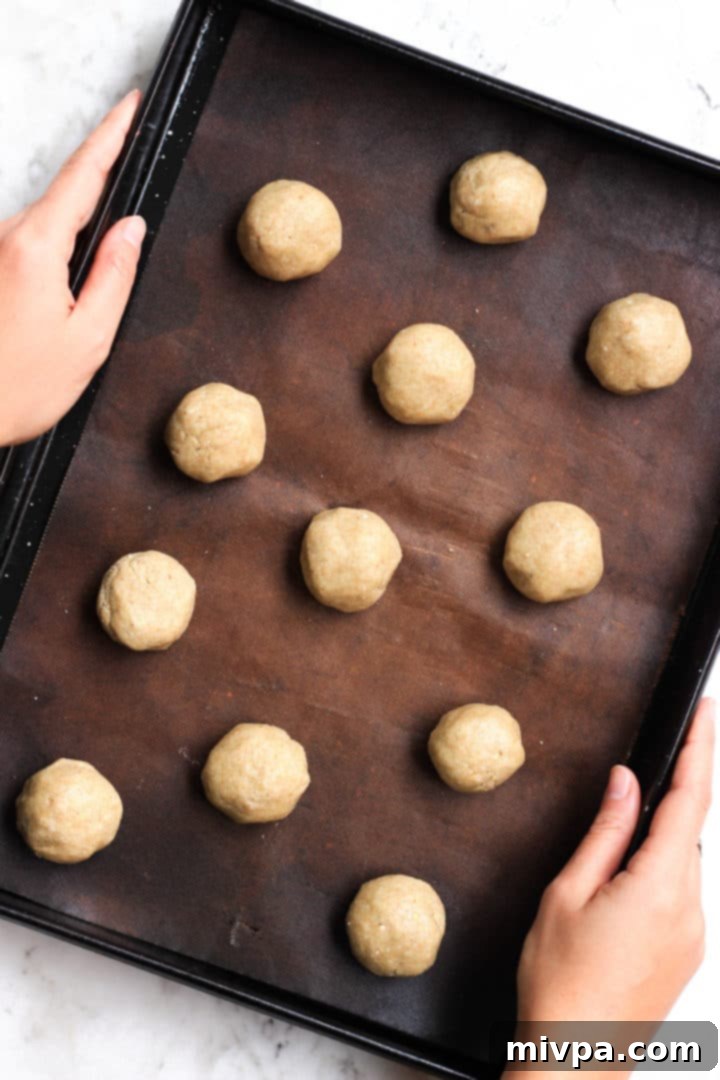
5: Gently Flatten the Dough
With clean fingers, gently press down on each cookie dough ball, flattening them slightly. This step helps them bake evenly and achieve that signature crispy-on-the-outside, soft-on-the-inside texture that makes these buckwheat cookies so irresistible.
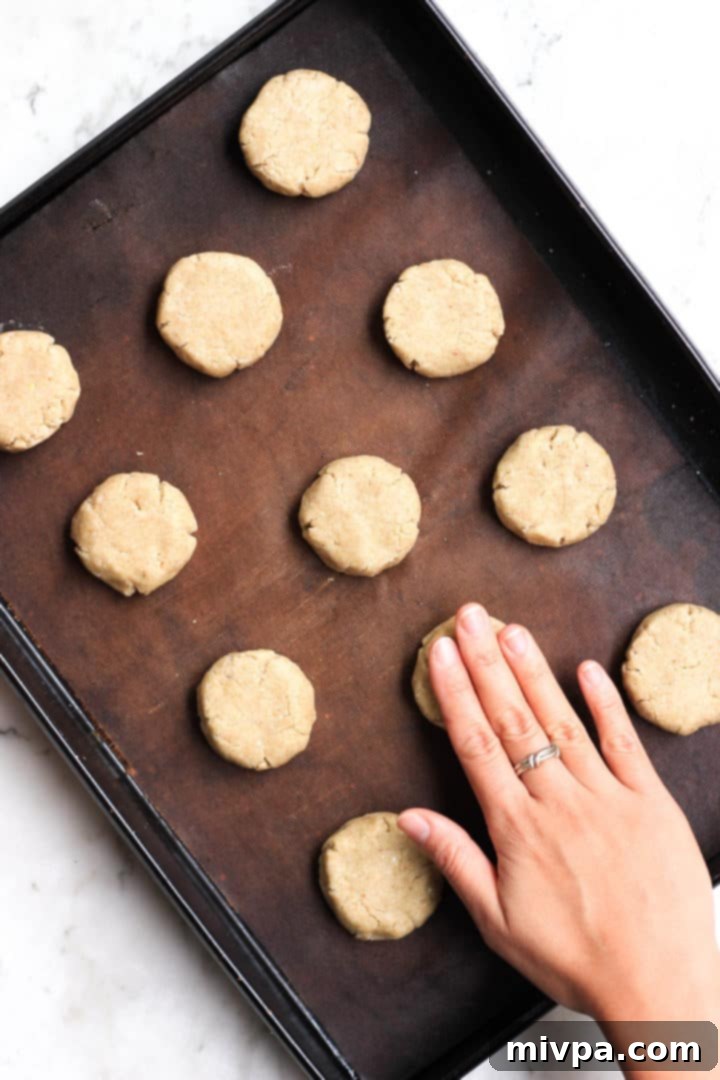
6. Bake to Golden Perfection
Transfer the baking sheet to your preheated oven and bake the cookies for 10 to 12 minutes. Keep a close eye on them; they are ready when the bottoms turn a beautiful golden brown. This indicates they are perfectly cooked through and will develop that desired crispness.
7. Cool and Indulge!
Once baked, resist the urge to immediately devour them! Allow the cookies to cool on the baking sheet for at least 10 minutes. This crucial cooling time allows them to set and firm up before you transfer them to a wire rack to cool completely. Patience is a virtue here, as it ensures they maintain their shape and develop their optimal texture. Finally, it’s time to savor every bite of these truly delicious gluten-free buckwheat cookies!
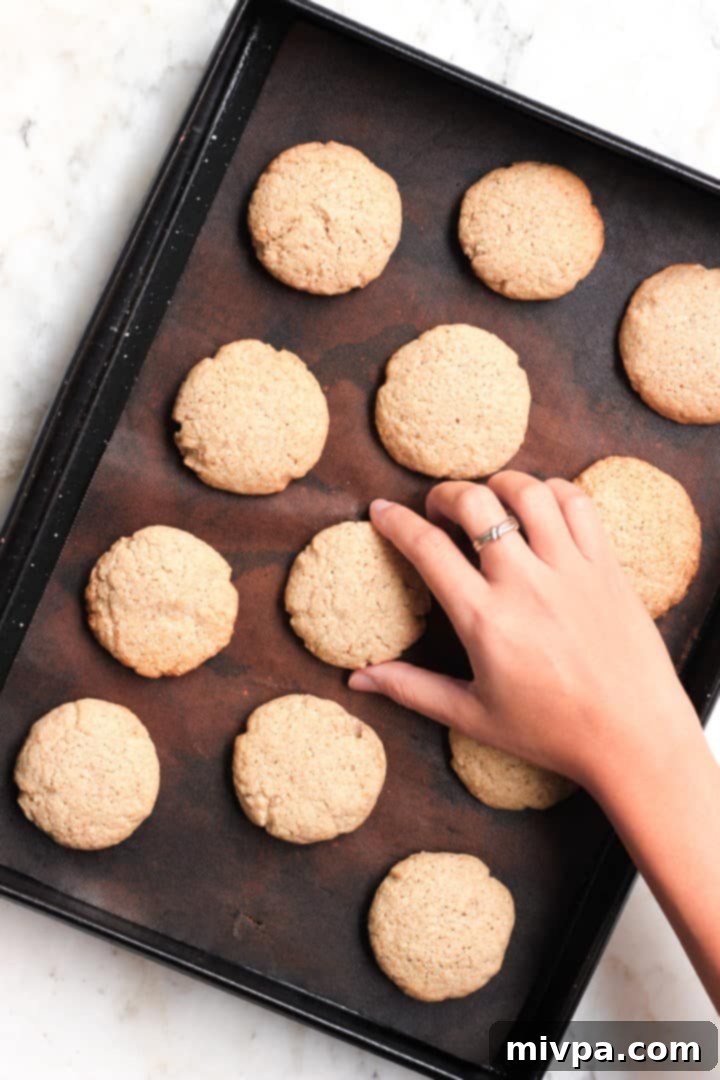
Dish by Dish Pro Tips & Tricks:
- Essential Baking Sheet Prep: To guarantee your buckwheat cookies don’t stick to the baking sheet, proper lining is key. I highly recommend using a silpat baking mat. Not only does it provide an excellent non-stick surface, but it’s also washable, reusable, and incredibly durable, making it a sustainable choice for countless baking sessions. If you don’t have a silpat, a sheet of good quality parchment paper will work just as well.
- Practice Patience for Perfect Cookies: It might be challenging to resist these heavenly cookies straight out of the oven, but allowing them to cool for a few minutes on the baking sheet before transferring them to a cooling rack is vital. This brief resting period helps the cookies firm up and develop their characteristic crisp exterior, preventing them from crumbling or breaking when moved. Full cooling ensures the best texture and structural integrity.
- Indulge in Chocolate Buckwheat Cookies: For all the chocolate lovers out there, transforming this recipe into a rich chocolate cookie is incredibly simple. Just substitute 1/4 cup of the buckwheat flour with unsweetened cocoa powder when adding the dry ingredients to the dough. The earthy notes of buckwheat pair beautifully with chocolate, creating a deeply satisfying treat.
- Optional Delightful Add-Ins: Want to add another layer of flavor and texture? Feel free to fold in a handful of your favorite chocolate chips into the cookie dough. This simple addition creates wonderful buckwheat chocolate chip cookies that are sure to be a crowd-pleaser. Other additions like chopped nuts or dried cranberries could also be delightful!
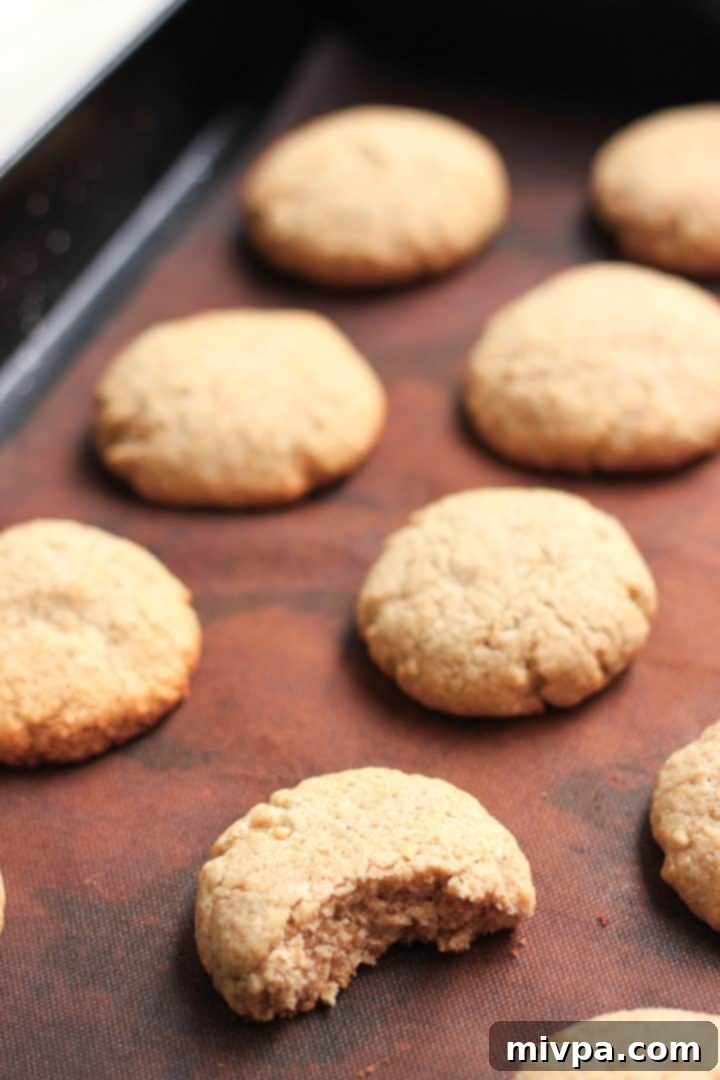
Common Questions About Buckwheat Cookies:
The color variation in your buckwheat cookies primarily depends on the type of buckwheat flour used. If your buckwheat flour was ground from hulled buckwheat groats, the flour, and thus the cookies, will typically be lighter in color. Conversely, if the flour was made from groats with the hulls still on, it will yield a darker flour and result in cookies with a deeper, richer hue. Both are perfectly fine and taste wonderful!
Absolutely! Despite its deceptive name, buckwheat is not related to wheat in any way. It’s actually a seed, and a highly nutritious pseudocereal at that. This means it is naturally 100% gluten-free. Individuals with Celiac disease, gluten allergies, or intolerances can confidently enjoy buckwheat and its derived products, like these delicious cookies, without any concerns.
To maintain their freshness and delightful crispness, store these buckwheat cookies in an airtight container. They will keep beautifully at room temperature for up to 5 days, making them perfect for meal prepping snacks or treats throughout the week.
Yes, you certainly can! Preparing the dough ahead of time and freezing it is a fantastic way to enjoy freshly baked cookies whenever a craving strikes. Simply wrap the cookie dough tightly in several layers of plastic wrap, then place it in a freezer-safe bag or container. It can be frozen for up to 2 months. When you’re ready to bake, transfer the dough to the refrigerator to thaw overnight before rolling it into balls and baking according to the instructions.
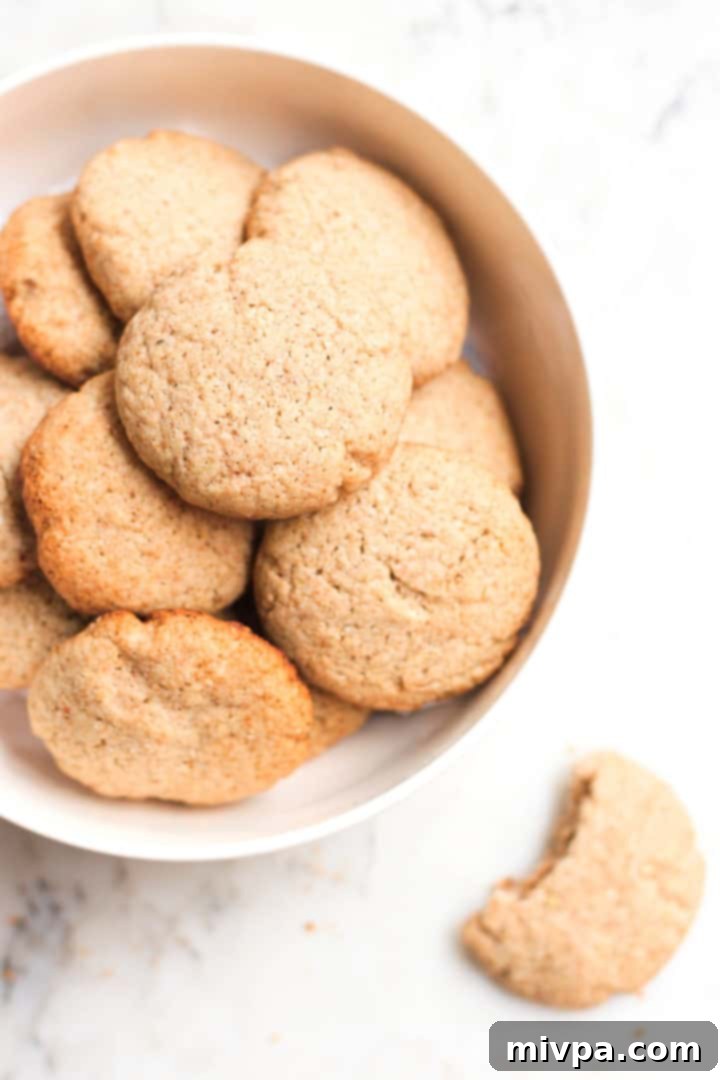
More Delicious Buckwheat Recipes to Explore:
- 5-Minute Homemade Buckwheat Flour (Gluten-Free, Vegan)
- Soft, Fluffy Buckwheat Bread (Gluten-Free, Dairy-Free)
- Buckwheat Banana Bread (Gluten-Free, Dairy-Free)
- Easy Buckwheat Crepes (Gluten-Free, Dairy-Free)
- Buckwheat Porridge (Gluten-Free, Vegan)
Other Gluten-Free Cookie Recipes You’ll Absolutely Love:
- Tahini Chocolate Chip Cookies (Gluten-Free, Dairy-Free)
- Gluten-Free Linzer Cookies (Dairy-Free)
- Heart Jam Cookies (Gluten-Free, Dairy-Free)
- Gluten-Free Christmas Sugar Cookies (Dairy-Free)
P.S. If you try this recipe, I’d love for you to leave a star rating below, and/or a review in the comment section further down the page. I always appreciate your feedback. Be sure to check out my entire Recipe Index for all the recipes on the blog. You can also follow me on Pinterest, Facebook or Instagram! Sign up for my Email List to get fresh recipes in your inbox each week!
Print
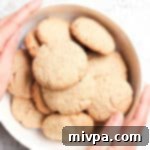
Gluten-free Buckwheat Cookies
5 Stars 4 Stars 3 Stars 2 Stars 1 Star
4.9 from 14 reviews
Author: felicia | Dish by Dish
Total Time: 22 minutes
Yield: 12 cookies
Diet: Gluten Free
Description
These incredibly crispy buckwheat cookies are a breeze to make, taking less than 30 minutes from start to finish, and they taste absolutely divine! They’re a perfect choice for an easy breakfast on the go, a satisfying snack any time of day, or even as delightful holiday treats. Plus, they’re entirely gluten-free and dairy-free, making them suitable for many dietary needs. I’ll also share my simple trick for making your own fresh buckwheat flour at home with just a blender – it’s surprisingly easy and much more economical!
Ingredients
Units
Scale
- 1/2 cup of granulated sugar
- 3/4 cup of softened coconut oil
- 1 large egg (or egg substitute like flax egg)
- 1 1/2 cups of buckwheat flour (homemade from buckwheat groats recommended)
- 1 teaspoon of certified gluten-free baking powder
- Pinch of salt (enhances flavors)
Instructions
- Preheat Oven & Prepare Sheet: Preheat your oven to 350F (180C). Line a large cookie sheet with parchment paper or a silpat baking mat.
- Mix Wet Ingredients: In a large bowl, cream together the sugar and softened coconut oil. Then, add the egg and mix until well combined and smooth.
- Combine with Dry: Add the buckwheat flour, baking powder, and salt to the wet mixture. Mix thoroughly until a homogeneous cookie dough forms.
- Form Cookie Balls: Using a cookie scoop or a heaping teaspoon, portion out the dough and roll it between your palms to form approximately 12 uniform cookie dough balls.
- Arrange & Flatten: Place the dough balls evenly spaced on the prepared cookie sheet. Gently press down on each ball with your fingers to flatten them slightly.
- Bake: Bake the cookies for 10 to 12 minutes, or until the edges are golden brown.
- Cool: Let the cookies cool on the baking sheet for at least 10 minutes to firm up before carefully transferring them to a wire rack to cool completely. Enjoy your homemade gluten-free buckwheat cookies!
Recipe Notes & Expert Tips
Sugar Choices: While white sugar works beautifully in these buckwheat cookies, you have several delicious alternatives! Feel free to use light brown sugar, dark brown sugar, or coconut sugar for a different flavor profile and slightly chewier texture. Keep in mind that darker sugars will naturally result in a darker cookie dough and a richer final color. For those mindful of blood sugar, Lakanto monk fruit sweetener is an excellent 1:1 sugar substitute with a zero glycemic index.
Coconut Oil Options: I prefer refined coconut oil for baking as its neutral flavor doesn’t overpower the buckwheat. If you enjoy a subtle coconut essence, extra virgin coconut oil will provide that. For non-dairy options, vegan butter is a great alternative. If you consume dairy, regular butter or ghee can be used in the same quantity.
Egg Substitutions for Vegan/Egg-Free: To make this recipe completely egg-free, you can easily substitute the egg. A commercial egg-replacer, aquafaba (3 tablespoons per egg), or a homemade flax egg (1 tablespoon ground flaxseed meal mixed with 3 tablespoons water, let sit for 5 minutes) all work well.
Homemade Buckwheat Flour Tips: To achieve the best results with homemade buckwheat flour, grind buckwheat groats in a high-speed blender. Work in small batches, about 1/2 cup of groats at a time, until a very fine flour is achieved. Approximately 1 1/4 cups of groats will yield 1 1/2 cups of buckwheat flour, which is exactly what you need for this recipe.
Understanding Flour Color: The color of your buckwheat flour and cookies can vary. Flour ground from hulled buckwheat groats will be lighter, while flour from groats with the hulls still on will result in a darker, more rustic appearance. Both types are delicious and perform well in baking.
Baking Powder Importance: As the sole leavening agent, baking powder is crucial for the texture of these cookies. Ensure it’s fresh and active. If you have Celiac disease or gluten intolerance, always use a certified gluten-free baking powder to prevent cross-contamination.
Storing Your Cookies: Once completely cooled, store your buckwheat cookies in an airtight container at room temperature. They will remain fresh and delightfully crispy for up to 5 days, perfect for enjoying throughout the week.
Recipe adapted from: Nami-Nami
- Prep Time: 10 mins
- Cook Time: 12 mins
- Category: Snacks
- Method: Baking
- Cuisine: American
